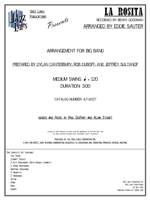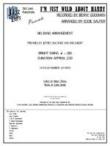LA ROSITA
Recorded by Benny Goodman
Arranged by Eddie Sauter, Prepared by Dylan Canterbury, Rob DuBoff, and Jeffrey Sultanot

Cat #: JLP-8327
$65.00This item usually ships within 1 business day.
Questions?
Please call +1-518-587-1102 or email us.
Edition: Jazz Big Band Arrangement
Description: Swing - Difficult
Publisher: Jazz Lines Publications
Eddie Sauter's arrangements for the Benny Goodman Orchestra resulted in some of the most consistently envelope-pushing performances by the great clarinetist. This take on the popular song "La Rosita" was recorded and released in 1941. Goodman may not have been at the height of his popularity anymore, but the level of musicianship within his band certainly didn't suffer as a result.
The arrangement begins with the saxophones whisking in a Billy Butterfield trumpet cadenza that has more in common with the bravura stylings of classical soloists than jazz soloists. The ensemble re-enters when Butterfield's solo climaxes, with a winding saxophone line and some quick wah-wah-ing brass setting up Goodman's entrance with the melody at measure 10. The melody should be performed in a fairly straight manner, with the simple but warm backgrounds never overwhelming the soloist.
The fiery introductory figure returns at measure 26, but this time has two measures tacked on that counteract the decrease in volume with an equal swell back up toward the end. The tune shifts to a minor key at measure 32. At this point, the saxes carry out a quasi-rumba rhythm underneath some trading back and forth between a muted trumpet trio handling the melody and a clarinet trio interjecting commentary. The trombones co-opt the melody beginning at measure 48, with some continued intricate call-and-response passages between the rest of the horns. The trombones continue to carry the melody through the stop-time feel at measure 56 before Butterfield's trumpet returns to the fore at measure 64. The key changes back to major, with the trumpet handling the melody duties over the top of the rest of the ensemble. The background figures are occasionally quite intricate during this part; in particular some of the sweeping woodwind arpeggios will require some quick finger technique. Goodman's clarinet trills the melody back for the final portion of the arrangement at measure 80, which sees yet another key change. The final few measures should very gradually taper off in volume, but once the audience is lulled into a false sense of security a brief but loud snap from the full band wakes them back up just in time for things to finish up.
This arrangement is for jazz big band with clarinet soloist. Most of the arrangement has been prepared from the original parts used during the 1941 recording session, with the exception of the baritone saxophone part, which appears to have been lost over the years. It has been transcribed accordingly.
Clarinet Soloist
2 Alto Saxophones (Both Double Clarinet)
2 Tenor Saxophones
Baritone Saxophone
3 Trumpets
2 Trombones
Guitar
Piano
Bass
Drums
Trombone 1: C5








![FOCUS [SCORE] View: FOCUS [SCORE]](https://www.ejazzlines.com/wp-images/product/thumbnail/jlp-8900.jpg)

